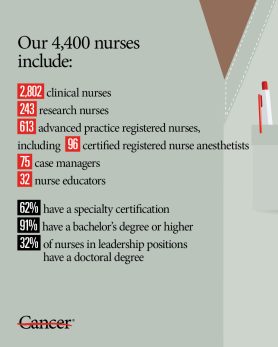- Diseases
- Acoustic Neuroma (14)
- Adrenal Gland Tumor (24)
- Anal Cancer (68)
- Anemia (2)
- Appendix Cancer (16)
- Bile Duct Cancer (26)
- Bladder Cancer (72)
- Brain Metastases (28)
- Brain Tumor (232)
- Breast Cancer (714)
- Breast Implant-Associated Anaplastic Large Cell Lymphoma (2)
- Cancer of Unknown Primary (4)
- Carcinoid Tumor (8)
- Cervical Cancer (158)
- Colon Cancer (166)
- Colorectal Cancer (116)
- Endocrine Tumor (4)
- Esophageal Cancer (44)
- Eye Cancer (36)
- Fallopian Tube Cancer (8)
- Germ Cell Tumor (4)
- Gestational Trophoblastic Disease (2)
- Head and Neck Cancer (12)
- Kidney Cancer (128)
- Leukemia (340)
- Liver Cancer (50)
- Lung Cancer (286)
- Lymphoma (278)
- Mesothelioma (14)
- Metastasis (30)
- Multiple Myeloma (100)
- Myelodysplastic Syndrome (60)
- Myeloproliferative Neoplasm (4)
- Neuroendocrine Tumors (16)
- Oral Cancer (100)
- Ovarian Cancer (172)
- Pancreatic Cancer (160)
- Parathyroid Disease (2)
- Penile Cancer (14)
- Pituitary Tumor (6)
- Prostate Cancer (146)
- Rectal Cancer (58)
- Renal Medullary Carcinoma (6)
- Salivary Gland Cancer (14)
- Sarcoma (238)
- Skin Cancer (294)
- Skull Base Tumors (56)
- Spinal Tumor (12)
- Stomach Cancer (64)
- Testicular Cancer (28)
- Throat Cancer (92)
- Thymoma (6)
- Thyroid Cancer (96)
- Tonsil Cancer (30)
- Uterine Cancer (80)
- Vaginal Cancer (16)
- Vulvar Cancer (20)
- Cancer Topic
- Adolescent and Young Adult Cancer Issues (20)
- Advance Care Planning (10)
- Biostatistics (2)
- Blood Donation (18)
- Bone Health (8)
- COVID-19 (362)
- Cancer Recurrence (120)
- Childhood Cancer Issues (120)
- Clinical Trials (630)
- Complementary Integrative Medicine (22)
- Cytogenetics (2)
- DNA Methylation (4)
- Diagnosis (232)
- Epigenetics (6)
- Fertility (62)
- Follow-up Guidelines (2)
- Health Disparities (14)
- Hereditary Cancer Syndromes (126)
- Immunology (18)
- Li-Fraumeni Syndrome (8)
- Mental Health (116)
- Molecular Diagnostics (8)
- Pain Management (62)
- Palliative Care (8)
- Pathology (10)
- Physical Therapy (18)
- Pregnancy (18)
- Prevention (912)
- Research (392)
- Second Opinion (74)
- Sexuality (16)
- Side Effects (604)
- Sleep Disorders (10)
- Stem Cell Transplantation Cellular Therapy (216)
- Support (402)
- Survivorship (320)
- Symptoms (182)
- Treatment (1786)
What does a nursing Magnet designation mean?
4 minute read | Published October 13, 2020
Medically Reviewed | Last reviewed by an MD Anderson Cancer Center medical professional on October 13, 2020
Chief Nursing Officer and Senior Vice President Carol Porter, D.N.P., formed her first impressions of MD Anderson as a Magnet appraiser in 2010.
“Before the visit, I read through MD Anderson’s application, which was several thousand pages, and I remember thinking, ‘this is amazing – it can’t be real,’” Porter recalls. Over her five-day survey, she witnessed the interdisciplinary teamwork, leading professional practices and evidence-based process improvements described in the application.
“I was so impressed with the nurses and the entire organization,” she says. “And I’m here now because of that introduction.”
In 2001, MD Anderson became one of the first hospitals in the U.S. to achieve Magnet designation, setting the bar high. And in 2020, we’ve gone even higher by achieving our fifth consecutive designation, a distinction that only about 20 hospitals across the nation have achieved.
Here are five things you should know about MD Anderson’s Magnet designation.
1. Magnet designation is the gold standard in nursing
The Magnet Recognition Program was developed by the American Nurses Credentialing Center (ANCC) to recognize health care organizations that provide the best nursing care. Achieving Magnet status is the highest international distinction for nursing excellence and provides patients with the ultimate benchmark for measuring quality of care.
ANCC studies have demonstrated that Magnet-recognized hospitals typically provide a higher quality of patient care, including lower mortality rates and better patient satisfaction. Magnet hospitals have lower turnover and less burnout among nursing staff. And, as in Porter’s case, the recognition is directly linked to a hospital's ability to attract and retain qualified, highly educated nursing leaders and staff.

2. Organizations must re-apply every four years.
MD Anderson was one of the first 50 charter health care facilities to become Magnet designated in 2001. Jackie Anderson, Ph.D., Magnet program director and director of Nursing Quality, says the program has evolved since then.
Once centered on process and structure, the focus now is on data-driven outcomes and demonstrating that we consistently outperform national benchmarks in quality measures such as pressure injuries, falls with injury, central-line bloodstream infections, catheter-associated infections, and patient satisfaction scores.
“Going through the Magnet process is a continuation of all the recent work our organization has done in safety and quality – and it’s improved the care we provide,” says Anderson, who has led our last four redesignation efforts.
3. We have to show our work.
For our 2020 Magnet designation, our nurses submitted an electronic application that took about two years to write. The final document included more than 80 sources of evidence, which highlighted examples of evidence-based interdisciplinary practice, nurse-driven excellence in quality measures, and nursing research.
“For each source of evidence, we provide an example of how we met the standard,” Anderson explains. For example, when describing a nurse-led initiative related to evidence-based practice, we included who was involved in developing the program, baseline measurements and patient outcomes that demonstrated improvement.
During the Magnet surveyors’ virtual site visit in August, appraisers saw our nursing professionals in action. They interviewed employees and patients to learn about our entire nursing community, including nurses working in clinical research, our advanced practice program, education and operations.
4. Magnet champions take the lead.
When Angela Yarbrough joined MD Anderson as a nurse practitioner in Pediatrics 10 years ago, she knew she’d found a culture that values nurses and encourages leading practices. She’s now active in educating fellow APRNs and others about evidence-based practice and Magnet.
Yarbrough co-leads more than 150 Magnet champions from across MD Anderson. They’re often referred to as the backbone of our Magnet-related education efforts.
“The champions go back to their departments and get staff engaged in the Magnet process,” she says. “They help nurses understand the terminology and tools they need to speak confidently with appraisers about their successes.”
While the preparation can be exhausting, Yarbrough says the designation energizes staff. “It’s well worth the effort because it validates the excellent work that we perform here every day.”
5. Magnet is a recognizable seal of approval.
Today, MD Anderson is among about 20 hospitals nationwide that have earned five consecutive Magnet designations.
Magnet status is an important factor used as a benchmark for accreditation by The Joint Commission and for reputational comparisons such as the U.S. News & World Report’s Best Hospitals survey.
“Our continuous Magnet designation should be a source of pride not only for nurses, but for all employees,” Anderson says. “It’s part of who we are and, most importantly, it assures patients and their families that they’re in expert hands at MD Anderson.”
Request an appointment at MD Anderson online or by calling 1-877-368-0183.
Related Cancerwise Stories

It validates the excellent work that we perform here every day.
Angela Yarborough
Advanced Practice Registered Nurse





